In a world of economic rollercoasters and constant disruptions, strategic control is your secret weapon for staying ahead of the game. A PWC survey revealed a telling statistic: 78% of global business leaders are bracing for substantial organizational transformation within three years.
Strategic control is your tool for turning these winds of change into tailwinds. It empowers your business to adapt, make confident decisions, and effectively manage resources.
In this article, we'll unpack the importance of strategic control, walk you through its process, and equip you with simple tools to help you capitalize on the inevitable waves of change.
What Is Strategic Control?
Strategic control is part of a strategic management process that shows how well your strategy is doing now, so you can further refine it for future execution. It helps you achieve future goals by evaluating historical performance so you can identify patterns and trends, and spot risks early on.
With the help of strategic control, you can find different ways of executing your strategy as the world shifts so you can continue to achieve your business goals.
The Importance Of Strategic Control
Better resource allocation
By exercising strategic control, you can avoid wasting your resources on strategic initiatives that yield no results. It helps you quickly identify which initiatives are performing well and which are falling flat, allowing you to allocate resources to high-impact strategic projects.
Fast adaptability
In the dynamic business landscape, adaptability is a necessity, not a choice. With strategic control, you can spot deviations or discrepancies from strategic plans early and take necessary corrective actions. This helps you respond quickly to market changes and seize emerging opportunities.
📚Recommended read: Strategy report: You’re doomed or you adapt
Confident decision-making
With strategic control, your decisions are backed by concrete data, not just hunches. It helps you make better data-driven decisions on which initiatives or projects to continue, modify, or abort. Say goodbye to costly guesswork and hello to confident, informed decision-making.
Strategic Control Process In 6 Steps
Here’s how you can enable an effective strategic control process in 6 steps:

1. Define strategic objectives
To have control over something, you must have a clear understanding of what you want to achieve. Gather and analyze relevant performance data to identify key areas for improvement or growth. Set clear and specific goals and objectives that align with the organization’s overall strategy.
These strategic objectives act as your roadmap toward your vision. Ensure they are structured properly, with a defined time frame and outcome.
2. Assign KPIs
Measure progress toward your strategic objectives using Key Performance Indicators (KPIs). Select the right KPIs that will help you benchmark performance. Our guide on how to write KPIs will help you craft unique ones that reflect your strategic goals.
3. Measure progress
Don’t just set up and forget your KPIs. Regularly measure performance standards to ensure you’re on the right path. Use strategy dashboards to gain visibility on what your team is doing and precisely measure progress against your KPIs.
4. Analyze performance
Piece the puzzle together by analyzing your organization’s performance and looking for patterns and trends that reveal any underlying issues. Look for strengths and weaknesses and identify opportunities for improvement. Use a strategy report to communicate these findings to the top management team and get everyone on the same page.
5. Analyze deviations
No strategy is perfect, so expect some deviations from your anticipated outcomes. This is perfectly normal and should be an opportunity to determine why these deviations happened in the first place. Discover what caused these below-standard performances and identify if there were cracks in your strategy or if uncontrollable forces were at play. Alternatively, the results could be better than anticipated, which will help to identify what works well and strengthen your strategy.
6. Adapt your strategy
Stop what’s not working and double down on what is. Adjust your objectives, KPIs, or overall strategy based on the results of your analysis. Reallocate resources where necessary, and change how you execute your current strategy. You may also need to revisit your organization’s overall strategic direction.
“As a business or brand, you have to remain agile at every level of the strategy to ensure that you're both responding to the market that could be changing before your eyes, but also creating value with the resources you have.” - Annie Lucchitti, Marketing Manager at Unilever
Common Fails With Strategic Control
Business strategies often fail not because companies fail to create one but because they fail at strategy implementation. The following are common setbacks that prevent strategic managers from executing control.
Siloed data
Isolation is our biggest enemy in this interconnected world. When we store data in isolated systems, it’s difficult to achieve a holistic view of strategic performance.
With so many tools available, business units and teams pick their favorites and generate data independent from other systems. They waste time going back and forth between reports, likely missing critical pieces of the puzzle. This siloed data hinders effective analysis and decision-making.
No visibility into alignment
Strategic control requires clear visibility into how various initiatives align with the organization's strategic objectives. Lack of visibility can result in disconnected efforts, redundant activities, or misaligned resource allocation.
For strategies to succeed, everyone from leaders to team members needs a bird’s eye view of that plan and its progress. Leaders must have the right tools, like executive dashboards, to quickly digest resource requirements, assign responsibilities, and identify bottlenecks. Team members must also have dashboards that help them see the big picture so they know how their work aligns with the overall strategy.
Lack of ongoing insights
Strategic control isn’t a waiting game. It’s about real-time insights into the progress you’re making. Use control systems like automated dashboards and regular performance reviews of metrics that showcase your strategy’s actual performance.
This will help you make timely decisions, catch opportunities as they arise, and address strategic risks before they snowball.
Lack of context
Measuring metrics without context is like reading a book in a language you don't understand. You and your teams must have a clear understanding of why you’re measuring certain metrics and how each one contributes to business outcomes.
You should also add context when analyzing strategic performance by knowing external factors, market conditions, and industry trends. Context helps transform raw data into meaningful insights and better-informed decisions.
Tools and Templates For Effective Strategic Control
OKR, KPIs, Balanced Scorecard—you can take your pick of any framework, but while they are great starting points for business plan formulation, they won’t solve your alignment and execution woes. You need tools and control techniques that go beyond the strategic planning process.
Moreover, you should keep things simple and avoid overcomplicating your strategies and frameworks to match the complexity of your market.
Strategy execution platform
Cascade keeps things simple and helps leaders effortlessly execute the organization’s strategies. It’s the world’s #1 strategy execution platform designed to unite strategic, financial, and operating information into a single view. With a glance, you’d know how your business performs at every level, so you can make the right decisions every time.
Unlike other tools in the market, Cascade doesn’t limit how your organization works. It seamlessly integrates with any tool or framework your teams use, optimizing workflows and boosting efficiency.
For example, your IT department uses JIRA, while your marketing department uses Monday.com. Cascade combines data from both tools to provide a holistic view of your organization’s performance. We won’t force your teams to change their current ways of working. Instead, we’ll integrate with their tools to provide you with a comprehensive view of the business.
Here are some key features:
Customizable strategy planner
Cascade supports various popular strategic planning models. This allows you to define your strategies and milestones in a method that works best for your team. With Cascade, you can build your strategies with structure and ease by breaking down the complexity from high-level initiatives to executable outcomes.
Smooth integrations
Cascade integrates with thousands of business tools so you can collect data throughout your organization and display them in clear visual reports. Let your team stick with what they know while you gather essential info and banish data silos.
Real-time dashboards
Cascade helps organizations align better using powerful strategy dashboards that build compelling narratives using visualized data. Leaders can uncover valuable insights that help them make informed decisions, while team members can remain motivated to drive results as they see the big picture come together.
.png)
Progress reports
Communicate progress to stakeholders, identify areas for improvement, and facilitate better decision-making with the help of regular and accurate strategy reports. Cascade simplifies the strategy reporting process so you can create useful reports that give you valuable insights to make smarter decisions.
.png)
Alignment map
Ensure activities and initiatives are consistently aligned with the organization’s strategic objectives using Cascade’s objective alignment map. With this feature, you can visualize how different organizational plans work together and how your overarching business strategy breaks down into operational and functional plans.
%20(1).png)
Metrics library
Track important metrics right within Cascade and say goodbye to the tedious task of going back and forth multiple spreadsheets. Cascade lets you import metrics like MRR, ARR, EBITDA, NPS, CSAT, and others from your Google Sheets or Excel right to Cascade. Save time, control standards, and drive faster results by bringing your metrics closer to your strategy.
Strategy templates
Effective strategies don't have to be complicated. It’s the simple ones that make the most impact. With these pre-filled templates, you can adopt a structured approach and set standards that everyone can easily follow.
These templates help you focus on key strategic initiatives that will significantly contribute to your business results:
- Digital Transformation Strategy
- Corporate Strategy Template
- Balanced Scorecard
- Business Growth Strategy Template
- Business Continuity Plan Template
- New Product Launch Plan Template
✨Not finding what you need? Check out our Strategy Template Library with 1,000+ templates that will help you to simplify your strategy.
Take Control Of Business Growth With Cascade 🚀
No one can accurately forecast the future but that doesn’t mean your organization has to operate in the dark. Strategic control is like having a crystal ball to keep your organization on the right path. Whether it’s monitoring progress, adjusting strategies, or spotting unexpected surprises, strategic control prepares your organization for the future.
But why go solo when you can have a dependable companion? Cascade guarantees a hassle-free and straightforward process without the pitfalls of poor strategy execution. It’s like having a trusty sidekick that streamlines strategic management control, saves you time, and helps you steer your organization in the right direction.
Ready to see Cascade in action? Start today for free or book a 1:1 product tour with Cascade’s in-house strategy expert.
Strategic Control FAQ
What are the three types of strategic control?
When it comes to strategic control, there are three types you should know about.
- Premise control focuses on ensuring that the initial assumptions and conditions underlying the strategy are still valid.
- Implementation control monitors the progress of executing the strategy and achieving the planned objectives.
- Strategic surveillance control involves keeping a watchful eye on the external environment to detect any significant changes or opportunities that might impact the strategy.
A fourth type, special alert control, comes into play when unexpected events or crises arise, requiring immediate attention and response.
What is the difference between operational and strategic control?
Operational control is like keeping an eye on the day-to-day stuff—making sure tasks are done efficiently, meeting short-term goals, and keeping operations running smoothly.
Strategic control is all about the big picture. It focuses on the long-term direction of the organization, monitoring progress toward strategic goals, and making adjustments to the overall strategy as needed.
Operational control is like zooming in on the details, while strategic control is like zooming out and thinking about the future.





.png)
.jpg)
.jpg)
%20(1)%20(1)%20(1)%20(1)%20(1).png)



